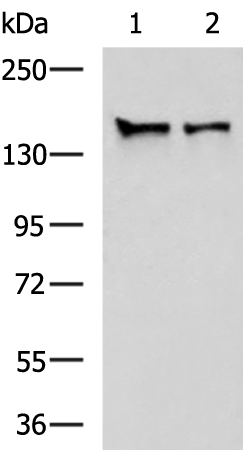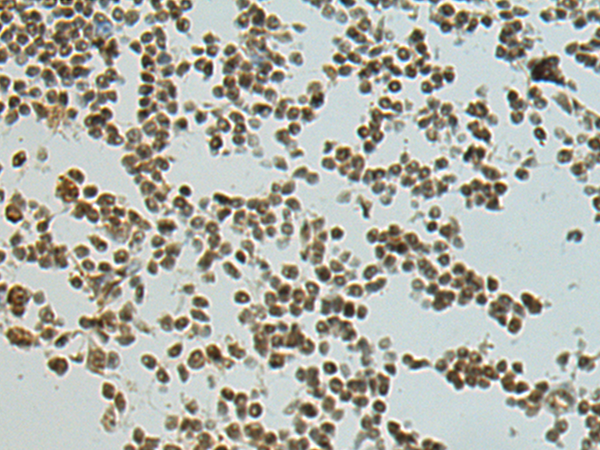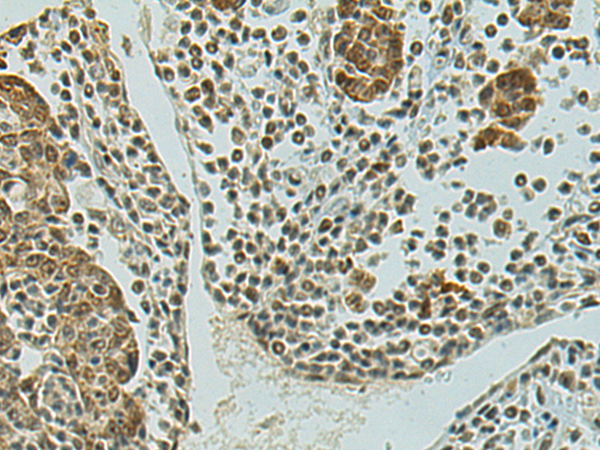


| WB | 咨询技术 | Human,Mouse,Rat |
| IF | 咨询技术 | Human,Mouse,Rat |
| IHC | 1/150-1/300 | Human,Mouse,Rat |
| ICC | 技术咨询 | Human,Mouse,Rat |
| FCM | 咨询技术 | Human,Mouse,Rat |
| Elisa | 1/5000-1/10000 | Human,Mouse,Rat |
| Aliases | SA1; MRD47; SCC3A |
| WB Predicted band size | 144 kDa |
| Host/Isotype | Rabbit IgG |
| Antibody Type | Primary antibody |
| Storage | Store at 4°C short term. Aliquot and store at -20°C long term. Avoid freeze/thaw cycles. |
| Species Reactivity | Human |
| Immunogen | Fusion protein of human STAG1 |
| Formulation | Purified antibody in PBS with 0.05% sodium azide and 50% glycerol. |
+ +
以下是3-4条关于STAG1抗体的参考文献示例(注:内容为模拟概括,具体文献请核实数据库):
1. **文献名称**:*STAG1 regulates cohesin complex integrity for mitotic chromosome dynamics*
**作者**:Smith A, et al.
**摘要**:研究通过STAG1抗体进行免疫沉淀和染色质免疫共沉淀(ChIP-seq),揭示了STAG1在维持黏连蛋白复合体稳定性及调控有丝分裂染色体分离中的关键作用。
2. **文献名称**:*STAG1 mutations in human neurodevelopmental disorders and cancer*
**作者**:Li J, et al.
**摘要**:利用STAG1抗体进行Western blot和免疫荧光分析,发现STAG1功能缺失突变与自闭症谱系障碍及某些癌症的基因组不稳定性相关。
3. **文献名称**:*Cohesin subunit STAG1 is required for hematopoietic stem cell maintenance*
**作者**:Wang Y, et al.
**摘要**:通过STAG1抗体敲低实验和小鼠模型,证明STAG1对造血干细胞自我更新和分化至关重要,其缺失导致白血病发生风险增加。
4. **文献名称**:*STAG1-mediated chromatin interactions modulate transcriptional regulation*
**作者**:Garcia E, et al.
**摘要**:使用STAG1抗体的Hi-C和3D基因组分析,揭示了STAG1通过介导染色质环形成调控基因表达的分子机制。
(注意:以上文献信息为示例性质,实际引用请以具体论文为准。)
The STAG1 antibody is a research tool used to detect STAG1 (Stromal Antigen 1), a core component of the cohesin complex, which plays critical roles in chromosome organization, sister chromatid cohesion, and transcriptional regulation. Cohesin, composed of SMC1. SMC3. RAD21. and STAG subunits, ensures proper chromosome segregation during cell division. STAG1. one of two stromal antigen paralogs (STAG1 and STAG2), contributes to cohesin's dynamic DNA-binding activity and tissue-specific functions. Dysregulation of STAG1 is linked to developmental disorders and cancers, particularly through mutations affecting cohesin's role in gene expression and genome stability.
STAG1 antibodies are widely employed in techniques like Western blotting, immunofluorescence, and chromatin immunoprecipitation (ChIP) to study its localization, interactions, and expression levels. Researchers use these antibodies to explore STAG1's involvement in mitotic regulation, DNA repair, and 3D chromatin architecture. Notably, STAG1-specific antibodies help distinguish its functions from STAG2. which shares structural similarities but exhibits distinct roles in certain cancers, such as myeloid malignancies. Recent studies also highlight STAG1's potential role in neurodevelopmental disorders, making its antibody a key reagent for mechanistic investigations. Validation of antibody specificity remains crucial due to homology among STAG family proteins.
×